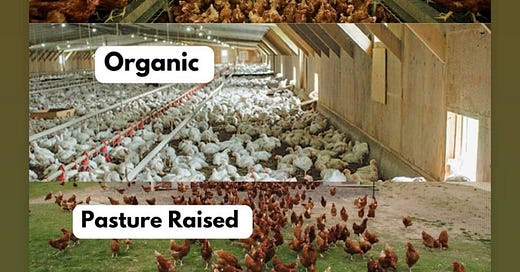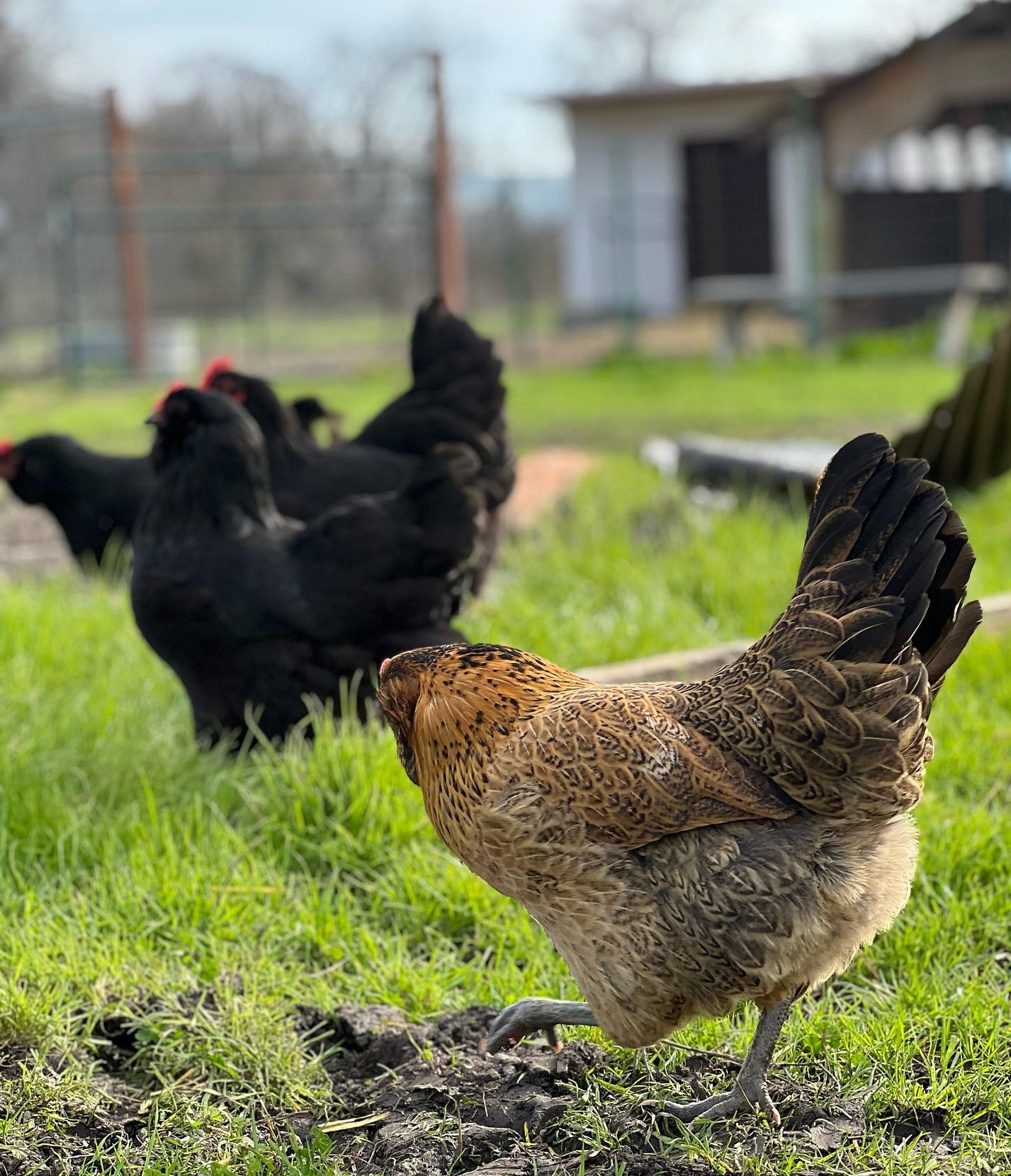I’ve been following the news about the price of eggs and haven’t seen any mainstream media outlets delve into the actual production models contributing to the cost of eggs. So I thought I’d take that on. At one time, Soul Food Farm was California's largest pastured chicken farm, so I can confidently say I know this subject well.
SIDE NOTE: Cage-free does not mean birds are not locked in warehouses. It only means they are not in cages. Organic only means what the chicken eats. It does not refer to how they are raised. Pastured means birds are outside on the grass and have accessible access to that grass.
The best way to start is by discussing the national, large-scale production model for food, specifically eggs and chicken meat. Large corporations, not small farmers, produce the majority of these two staples. Their primary business model is to create profits for their shareholders—not to prioritize animal welfare or consumer affordability.
What has made eggs falsely cheap for the average consumer is that the corporations they buy from own every aspect of the production process. Animals are raised in confined conditions without access to sunlight or the outdoors. Thousands of animals are crammed into warehouses to live out their usefulness. Is this beneficial to the animals? No. However, as a business model, it was established to control inventory, reduce costs, and maximize profits.
These operations are called vertically integrated systems, where the company owns everything: the birds, the buildings, the feed source, the labor, and the shipping trucks. The facilities where this model is applied are named CAFOs (Concentrated Animal Feeding Operations). This model isn’t limited to egg production; it’s also used for turkeys, pigs, and cattle. Visually, it’s horrific to witness, but as a money-making enterprise, it’s a well-established method among food corporations.
Many consumers don’t realize that while they expect eggs to be $1.99, there are hidden costs behind those “falsely cheap” eggs. These costs are paid through abused animals, water and air pollution, low wages for workers, impacted communities, and, ultimately, poor-quality food with little to no nutritional value.
At Soul Food Farm, we raised 3,000 laying hens and 12,000 meat birds on pasture. While on paper, it looked like a profitable enterprise; the reality is that small farmers receive no price breaks when purchasing inputs. Inputs include all the essentials of raising and marketing animals: buildings, straw, chicken feed, fuel, packaging, permits, chicks, boxes, equipment, and processing. These were the challenges Eric and I faced when we did all the work with one helper. All these inputs are paid at full retail prices, and fuel prices heavily influence the cost of everything. When fuel costs rise, it means smaller profit margins for family farmers.
Here is a short Film by Douglas Gayton about the different terms and ways of producing eggs.
The Story Of An Egg LINK
What drove us to build the chicken farm in the first place was a desire to raise birds outdoors, allowing them to express their natural behaviors: pecking for bugs, moving through grass, feeling the sun, and roosting as a flock. Alongside good food, clean water, and daily care, these elements created a food source as close to the best of nature as we could produce.
After many successful years of high-profile accounts, we closed our pastured chicken business in 2012 after exhausting every attempt to make the financials work. Besides the challenges inherent in raising birds outdoors, the math was impossible to overcome. Today, we sell chicken eggs for $10 at the farmstand and still don’t make a profit.
In short, small farmers are held hostage to market fluctuations. Unfortunately, while rising fuel costs must be paid immediately, small farmers can’t continually raise the prices of their products. This world of fast food and grocery store convenience has divorced most people from understanding the actual cost of food production—an understanding that previous generations, like our pre-WWII families, inherently had. Back then, there was no fast-food culture, massive warehouse stores like Costco, and no CAFOs. People bought food from their communities or farmers close to their cities. Grocery stores were mainly mom-and-pop operations.
In the race to industrialize the food system, we’ve created a production model that is abusive to both animals and workers and, in my opinion, to the customers who eat this food. The CAFO model produces food that fills bellies but doesn’t add meaningful, healthy calories to people’s diets. People are full but starving from a lack of real nutrition. And corporations have become monsters in the way they raise animals.
While most people can’t afford $10 eggs or don’t have access to farm-fresh eggs, the cost of eggs is driven by two main factors: corporations drive up prices to profit their shareholders, or small farmers sell eggs at essentially break-even prices. Either way, eggs do not cost $1.99 to produce in either system.
Of course, we must also consider that the avian flu has contributed to egg shortages. However, that is another murky topic. But notice that even when things return to “normal,” the price of eggs will not return to pre-avian flu levels.
As always, buy the best food you can afford and shop from small family farmers whenever possible.
And please, before I’m flooded with emails saying we shouldn’t eat animals, I understand the argument. But as a farmer, I must acknowledge that it is done, and large swaths of the population are not privileged enough to make that decision. While Soul Food Farm no longer produces chicken meat for consumption, we recognize that animals still have an inherent role in building soil health and creating healthy, diverse farm ecosystems. Since people are going to eat animals, we champion those small farmers who take on the responsibility of doing it in the most human way possible.






This is great, Alexis. Well said. We make food falsely cheap, waste most of it, and bury our heads thinking that we’ve progressed.
Thank you, Alexis for this articulate and straightforward presentation of the poultry aspect of the industrial food system in this country.
Understanding how the prevailing system deprives consumers of truly nutritious food at almost any price point is key in my mind to educating consumers.
What makes any food more nutritious in terms of how it is produced?
I remember hearing another farmer (Bob Cannard) talking about the care he put into the soil of his farm, and how that contributed to his veggies being vibrant and nutritious.
What makes an egg from a pasture-raised chicken more nutritious than the eggs from birds raised in the other ways? I can see and taste the difference, for sure. I can guess how that makes an egg more nutritious, but I don’t really know. Thank you!